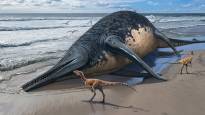According to the researchers, it was probably a marine reptile as long as two buses.
The pieces of bone found on the English coast in Somerset belonged to perhaps the world’s largest marine reptile, the public broadcasting company says BBC and CNN.
A creature estimated to be the length of two buses swam in the Sea almost 202 million years ago during the Triassic period, i.e. at the end of the age of dinosaurs.
A fossil finder Paul de la Salle found the jawbone in 2016 on a beach in Somerset, UK.
In 2020, father Justin Reynolds and an 11-year-old daughter Ruby found a similar fossilized jawbone in the area.
– Based on the size of the jawbones, one of which is over a meter long and the other two meters long, we can conclude that the animal was about 25 meters long, or about the size of a blue whale, says the paleontologist from the University of Bristol, who wrote the study Dean Lomax for the BBC.
According to him, however, more evidence is needed to confirm the size, such as the animal’s entire skeleton and skull.
If the estimates are correct, the discovery would come from two different individuals and it would be the world’s largest known marine reptile.
The researchers said in a paper published Wednesday in his reportthat the huge animal is a new species of ichthyosaur, which they have named Ichthyotitan severnensis.
The extinct fish lizards were top predators living in the sea.
According to the BBC, the discovery made by Paul de la Salle in 2016 will soon be displayed at the Bristol Art Museum in Britain.
